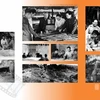 Kim Bong carpentry village in the ancient town of Hoi An, the central province of Quang Nam, is renowned for its wood carving and sculpture. Since 1999, Kim Bong artisans have made a vital contribution to the restoration of historic buildings in Hoi An ancient town. Since the 16th century, the village which originated in the north of Vietnam, has had its artisans work on furniture and houses across the country, from prominent buildings in Hanoi to Hue citadel and royal tombs or most of the architectural projects in Hoi An’s heyday. The style of Kim Bong carpentry is said to be the excellent combination of Cham kingdom, China, Japanese... and of course the talented hands of Vietnamese craftsmen. (Photo: Xuan Mai/Vietnam +)
Kim Bong carpentry village in the ancient town of Hoi An, the central province of Quang Nam, is renowned for its wood carving and sculpture. Since 1999, Kim Bong artisans have made a vital contribution to the restoration of historic buildings in Hoi An ancient town. Since the 16th century, the village which originated in the north of Vietnam, has had its artisans work on furniture and houses across the country, from prominent buildings in Hanoi to Hue citadel and royal tombs or most of the architectural projects in Hoi An’s heyday. The style of Kim Bong carpentry is said to be the excellent combination of Cham kingdom, China, Japanese... and of course the talented hands of Vietnamese craftsmen. (Photo: Xuan Mai/Vietnam +)  For many years, Kim Bong village has developed vigorously and formed three groups of artisans: ancient architectural construction, civil wooden furniture and shipbuilding. Whichever the group they are in, Kim Bong's craftsmen still keep their traditional manner of starting out as apprentices and earning the rank of master through years of hard work. Since the 17th century, Kim Bong carpenters have proved their talent when they built a warship for the Spanish navy. Since then Kim Bong carpentry has developed. However, in recent years the trade has started to fade away due to the decrease in the number of new carpenters. The village is struggling to keep the trade alive. (Photo: Xuan Mai/Vietnam+)
For many years, Kim Bong village has developed vigorously and formed three groups of artisans: ancient architectural construction, civil wooden furniture and shipbuilding. Whichever the group they are in, Kim Bong's craftsmen still keep their traditional manner of starting out as apprentices and earning the rank of master through years of hard work. Since the 17th century, Kim Bong carpenters have proved their talent when they built a warship for the Spanish navy. Since then Kim Bong carpentry has developed. However, in recent years the trade has started to fade away due to the decrease in the number of new carpenters. The village is struggling to keep the trade alive. (Photo: Xuan Mai/Vietnam+)  Since 1999, when Hoi An ancient town was declared a UNESCO World Heritage Site, Kim Bong artisans have made a vital contribution to the restoration of historic buildings. The village craftsmen were also responsible for most of the architectural details of the former imperial capital city of Hue. The first thing you hear when going to Kim Bong is the loudly punching and shearing sound; it is bringing vitality to this area. Hoi An used to be a busy commercial port in Vietnam's southern region in the past, so Kim Bong village had conditions to develop rapidly. With its convenient location, the import of raw materials or goods is easily, so the products of Kim Bong have been presented in many countries around the world. (Photo: Xuan Mai/Vietnam+)
Since 1999, when Hoi An ancient town was declared a UNESCO World Heritage Site, Kim Bong artisans have made a vital contribution to the restoration of historic buildings. The village craftsmen were also responsible for most of the architectural details of the former imperial capital city of Hue. The first thing you hear when going to Kim Bong is the loudly punching and shearing sound; it is bringing vitality to this area. Hoi An used to be a busy commercial port in Vietnam's southern region in the past, so Kim Bong village had conditions to develop rapidly. With its convenient location, the import of raw materials or goods is easily, so the products of Kim Bong have been presented in many countries around the world. (Photo: Xuan Mai/Vietnam+)  Traditional trade in Kim Bong is divided into 3 main areas as carpentry construction works of urban architecture, shipbuilding and usual carpentry. Most of the buildings in Hoi An are the contributions of the talented hands of this village: the ancient temple, house or family worship house…Not only appeared in Hoi An, another unique structure of Kim Bong carpentry is Hue Citadel. Back then, when the king of the Nguyen Dynasty decided to change the capital to Hue, he had to invite the carpenter from southern areas to construct: Kim Bong and Van Ha in Quang Nam. The village craftsmen were also responsible for most of the architectural details of the former imperial capital, Hue city. (Photo: Xuan Mai/Vietnam+)
Traditional trade in Kim Bong is divided into 3 main areas as carpentry construction works of urban architecture, shipbuilding and usual carpentry. Most of the buildings in Hoi An are the contributions of the talented hands of this village: the ancient temple, house or family worship house…Not only appeared in Hoi An, another unique structure of Kim Bong carpentry is Hue Citadel. Back then, when the king of the Nguyen Dynasty decided to change the capital to Hue, he had to invite the carpenter from southern areas to construct: Kim Bong and Van Ha in Quang Nam. The village craftsmen were also responsible for most of the architectural details of the former imperial capital, Hue city. (Photo: Xuan Mai/Vietnam+)  The products of this village are very different from the products elsewhere. They are kept in the original state or varnished to retain the natural beauty. While visiting the village, you will directly witness the crusting stages, to know that only one small product like wood buffalo or pig was made uneasily. In addition, you can admire the 1000 dragon carved clove was shown in the exhibition of Millennial Anniversary of Hanoi, Japanese Covered Bridge was moved intact. Village craftsmen also recently helped restore the Ngoc Gian pagoda in Da Nang and Tuan Chau tourist area in Quang Ninh province. In the photo: A work by Kim Bong carpenter. (Photo: Xuan Mai/Vietnam+)
The products of this village are very different from the products elsewhere. They are kept in the original state or varnished to retain the natural beauty. While visiting the village, you will directly witness the crusting stages, to know that only one small product like wood buffalo or pig was made uneasily. In addition, you can admire the 1000 dragon carved clove was shown in the exhibition of Millennial Anniversary of Hanoi, Japanese Covered Bridge was moved intact. Village craftsmen also recently helped restore the Ngoc Gian pagoda in Da Nang and Tuan Chau tourist area in Quang Ninh province. In the photo: A work by Kim Bong carpenter. (Photo: Xuan Mai/Vietnam+)  Kim Bong's products are not only sold and advertised widely, but its value is very famous. Vietnam people still come here to buy a piece of furniture, decorative furniture or hire someone to build an ancient house. The village craftsmen were also responsible for most of the architectural details of the former Imperial capital, Hue, and Ho Chi Minh’s imperial tomb. Certain special characteristics typical Kim Bong carpentry, such as stylised carvings of flowers, grass, trees and leaves using the cai trang (a tool to carve wood). The village's name comes from the Vietnamese kim (yellow) and bồng (floating), supposedly after the jackfruit wood that sometimes floats on the Thu Bon River. (Photo: Xuan Mai/Vietnam+)
Kim Bong's products are not only sold and advertised widely, but its value is very famous. Vietnam people still come here to buy a piece of furniture, decorative furniture or hire someone to build an ancient house. The village craftsmen were also responsible for most of the architectural details of the former Imperial capital, Hue, and Ho Chi Minh’s imperial tomb. Certain special characteristics typical Kim Bong carpentry, such as stylised carvings of flowers, grass, trees and leaves using the cai trang (a tool to carve wood). The village's name comes from the Vietnamese kim (yellow) and bồng (floating), supposedly after the jackfruit wood that sometimes floats on the Thu Bon River. (Photo: Xuan Mai/Vietnam+)  To deal with a marked decline of interest in the woodworking profession during the 20th century, the village successfully offered training and other incentives to young apprentices, resulting in an increase to over 200 woodworkers and 18 different woodcarving companies as of 2008. Additionally, a successful community-based tourism project in Kim Bồng has allowed greater tourism revenue for the village; the venture's success has been suggested as a pattern for future sustainable tourism projects throughout Southeast Asia. Kim Bong’s products have been sold on the domestic market and abroad and the village’s carpenters have been recognised by UNESCO for their efforts to preserve the traditional craft. (Photo: Xuan Mai/Vietnam+)
To deal with a marked decline of interest in the woodworking profession during the 20th century, the village successfully offered training and other incentives to young apprentices, resulting in an increase to over 200 woodworkers and 18 different woodcarving companies as of 2008. Additionally, a successful community-based tourism project in Kim Bồng has allowed greater tourism revenue for the village; the venture's success has been suggested as a pattern for future sustainable tourism projects throughout Southeast Asia. Kim Bong’s products have been sold on the domestic market and abroad and the village’s carpenters have been recognised by UNESCO for their efforts to preserve the traditional craft. (Photo: Xuan Mai/Vietnam+)  A work by Kim Bong artisan is on display at a national event several years ago. Kim Bong’s products have been sold on the domestic market and abroad and win over customers. The village craftsmen were also responsible for most of the architectural details of the former Imperial capital, Hue, and Ho Chi Minh’s imperial tomb. In the present day, Kim Bong craftsmen are often involved in restoration projects. For example, since the old town of Hoi An was designated a UNESCO World Heritage Site in 1999, many of the village's artisans have found work restoring historic buildings, some of which have remained otherwise untouched for hundreds of years. Local craftsmen have also worked on restoration projects in nearby Da Nang, and in Quang Ninh province. (Photo: Xuan Mai/Vietnam+)
A work by Kim Bong artisan is on display at a national event several years ago. Kim Bong’s products have been sold on the domestic market and abroad and win over customers. The village craftsmen were also responsible for most of the architectural details of the former Imperial capital, Hue, and Ho Chi Minh’s imperial tomb. In the present day, Kim Bong craftsmen are often involved in restoration projects. For example, since the old town of Hoi An was designated a UNESCO World Heritage Site in 1999, many of the village's artisans have found work restoring historic buildings, some of which have remained otherwise untouched for hundreds of years. Local craftsmen have also worked on restoration projects in nearby Da Nang, and in Quang Ninh province. (Photo: Xuan Mai/Vietnam+)  Simple traditional tools are used by Kim Bong artisans. This thin, straight tool is used to carve the delicate veins in a leaf or the eyelid of a dragon. Most other carpenters use a heavier, V-shaped tool. In more recent years, woodworking as a profession fell out of favour with young people, mainly due to poor returns: the average income of a woodworker in Kim Bong is about VND 1.5 million (85 US dollars) per month. By the 1990s, few master carvers remained in the village. To help promote the profession, Cam Kim commune created a program allowing young people to receive free training in carpentry and woodworking, along with providing a monthly stipend of VND 150,000 (8 US dollars) and tools of the trade. (Photo: Xuan Mai/Vietnam+)
Simple traditional tools are used by Kim Bong artisans. This thin, straight tool is used to carve the delicate veins in a leaf or the eyelid of a dragon. Most other carpenters use a heavier, V-shaped tool. In more recent years, woodworking as a profession fell out of favour with young people, mainly due to poor returns: the average income of a woodworker in Kim Bong is about VND 1.5 million (85 US dollars) per month. By the 1990s, few master carvers remained in the village. To help promote the profession, Cam Kim commune created a program allowing young people to receive free training in carpentry and woodworking, along with providing a monthly stipend of VND 150,000 (8 US dollars) and tools of the trade. (Photo: Xuan Mai/Vietnam+)  Most other carpenters use a heavier, V-shaped tool to produce sophisticated products. Kim Bong’s products have been sold on the domestic market and abroad and win over customers. The village craftsmen were also responsible for most of the architectural details of the former Imperial capital, Hue, and Ho Chi Minh’s imperial tomb. In the present day, Kim Bong craftsmen are often involved in restoration projects. For example, since the old town of Hoi An was designated a UNESCO World Heritage Site in 1999, many of the village's artisans have found work restoring historic buildings, some of which have remained otherwise untouched for hundreds of years. Local craftsmen have also worked on restoration projects in nearby Da Nang, and in Quang Ninh province. (Photo: Xuan Mai/Vietnam+)
Most other carpenters use a heavier, V-shaped tool to produce sophisticated products. Kim Bong’s products have been sold on the domestic market and abroad and win over customers. The village craftsmen were also responsible for most of the architectural details of the former Imperial capital, Hue, and Ho Chi Minh’s imperial tomb. In the present day, Kim Bong craftsmen are often involved in restoration projects. For example, since the old town of Hoi An was designated a UNESCO World Heritage Site in 1999, many of the village's artisans have found work restoring historic buildings, some of which have remained otherwise untouched for hundreds of years. Local craftsmen have also worked on restoration projects in nearby Da Nang, and in Quang Ninh province. (Photo: Xuan Mai/Vietnam+)  Products of Kim Bong, located in the central province of Quang Nam, have been sold on the domestic market and abroad. Training courses are provided by local master carver Huynh Ri, whose family includes 12 generations of woodcarvers. Several other local woodworking studios also provide on-the-job training to apprentice woodcarvers. These training programs have resulted in an increase in skilled woodworkers: the village numbered over 200 workers and 18 different woodcarving companies as of 2008. These results were lauded by the UNESCO as ‘keeping the traditional skills and intangible heritage of the ancient town of Hoi An and its surrounding villages alive’. In photo: A work by Kim Bong artisans. (Photo: Xuan Mai/Vietnam+)
Products of Kim Bong, located in the central province of Quang Nam, have been sold on the domestic market and abroad. Training courses are provided by local master carver Huynh Ri, whose family includes 12 generations of woodcarvers. Several other local woodworking studios also provide on-the-job training to apprentice woodcarvers. These training programs have resulted in an increase in skilled woodworkers: the village numbered over 200 workers and 18 different woodcarving companies as of 2008. These results were lauded by the UNESCO as ‘keeping the traditional skills and intangible heritage of the ancient town of Hoi An and its surrounding villages alive’. In photo: A work by Kim Bong artisans. (Photo: Xuan Mai/Vietnam+)  A sophisticated and graceful bird cage. Kim Bong’s products have been sold on the domestic market and abroad and the village’s carpenters have been recognised by UNESCO for their efforts to preserve the traditional craft. In the present day, Kim Bong craftsmen are often involved in restoration projects. For example, since the old town of Hoi An was designated a UNESCO World Heritage Site in 1999, many of the village's artisans have found work restoring historic buildings, some of which have remained otherwise untouched for hundreds of years. Local craftsmen have also worked on restoration projects in nearby Da Nang, and in Quang Ninh province.(Photo: Xuan Mai/Vietnam+)
A sophisticated and graceful bird cage. Kim Bong’s products have been sold on the domestic market and abroad and the village’s carpenters have been recognised by UNESCO for their efforts to preserve the traditional craft. In the present day, Kim Bong craftsmen are often involved in restoration projects. For example, since the old town of Hoi An was designated a UNESCO World Heritage Site in 1999, many of the village's artisans have found work restoring historic buildings, some of which have remained otherwise untouched for hundreds of years. Local craftsmen have also worked on restoration projects in nearby Da Nang, and in Quang Ninh province.(Photo: Xuan Mai/Vietnam+)  A carpentry workshop with countless unique artifacts. Products of Kim Bong, located in the central province of Quang Nam, have been sold on the domestic market and abroad. The village is also selected as a promising location for the project because of its proximity to Hoi An (already a major tourist destination), which provided an existing tourist base, and its existing craft sector. A dual pedestrian-bicycle trail was established to lead visitors through the village to see the local woodworking shops, where they are able to observe craftsmen working and purchase their products. This has helped the locals earn significant income from tourism activities. (Photo: Xuan Mai/Vietnam+)
A carpentry workshop with countless unique artifacts. Products of Kim Bong, located in the central province of Quang Nam, have been sold on the domestic market and abroad. The village is also selected as a promising location for the project because of its proximity to Hoi An (already a major tourist destination), which provided an existing tourist base, and its existing craft sector. A dual pedestrian-bicycle trail was established to lead visitors through the village to see the local woodworking shops, where they are able to observe craftsmen working and purchase their products. This has helped the locals earn significant income from tourism activities. (Photo: Xuan Mai/Vietnam+)  A product by Kim Bong artisan. Kim Bong’s products have been sold on the domestic market and abroad and the village’s carpenters have been recognised by UNESCO for their efforts to preserve the traditional craft. In more recent years, woodworking as a profession fell out of favour with young people, mainly due to poor returns: the average income of a woodworker in Kim Bong is about VND 1.5 million VND (85 US dollars) per month. By the 1990s, few master carvers remained in the village. To help promote the profession, Cam Kim commune created a program allowing young people to receive free training in carpentry and woodworking, along with providing a monthly stipend of VND 150,000 (8US dollars) and tools of the trade. (Photo: Xuan Mai/Vietnam+)
A product by Kim Bong artisan. Kim Bong’s products have been sold on the domestic market and abroad and the village’s carpenters have been recognised by UNESCO for their efforts to preserve the traditional craft. In more recent years, woodworking as a profession fell out of favour with young people, mainly due to poor returns: the average income of a woodworker in Kim Bong is about VND 1.5 million VND (85 US dollars) per month. By the 1990s, few master carvers remained in the village. To help promote the profession, Cam Kim commune created a program allowing young people to receive free training in carpentry and woodworking, along with providing a monthly stipend of VND 150,000 (8US dollars) and tools of the trade. (Photo: Xuan Mai/Vietnam+)  Bamboo dragons are carved on Kim Bong product. Artisans from other locations often depict dragons as ferocious and imposing, an influence of ancient feudal rights while the dragon carvings from Kim Bong are often cheerful. As the neighbouring town of Hoi An developed during the late 16th and early 17th centuries, Kim Bong's carpenters and woodworkers became more widely known; in the 17th century, local carpenters were supposedly commissioned to build a warship for the Spanish navy. Craftsmen from Kim Bong also produced most of the detail work on the buildings of the former Imperial capital in Hue, and, more recently, on Vietnamese revolutionary leader Ho Chi Minh's tomb. (Photo: Xuan Mai / Vietnam +)
Bamboo dragons are carved on Kim Bong product. Artisans from other locations often depict dragons as ferocious and imposing, an influence of ancient feudal rights while the dragon carvings from Kim Bong are often cheerful. As the neighbouring town of Hoi An developed during the late 16th and early 17th centuries, Kim Bong's carpenters and woodworkers became more widely known; in the 17th century, local carpenters were supposedly commissioned to build a warship for the Spanish navy. Craftsmen from Kim Bong also produced most of the detail work on the buildings of the former Imperial capital in Hue, and, more recently, on Vietnamese revolutionary leader Ho Chi Minh's tomb. (Photo: Xuan Mai / Vietnam +)  Craftsmen from Kim Bong also produced most of the detail work on the buildings of the former Imperial capital in Hue, and, more recently, on Vietnamese revolutionary leader Ho Chi Minh's tomb. With the skillful hands, Kim Bong artisans create extremely unique sculptures. Kim Bong’s products have been sold on the domestic market and abroad and the village’s carpenters have been recognised by UNESCO for their efforts to preserve the traditional craft. In the present day, Kim Bong craftsmen are often involved in restoration projects. For example, since the old town of Hoi An was designated a UNESCO World Heritage Site in 1999, many of the village's artisans have found work restoring historic buildings, some of which have remained otherwise untouched for hundreds of years. (Photo: Xuan Mai/Vietnam +)
Craftsmen from Kim Bong also produced most of the detail work on the buildings of the former Imperial capital in Hue, and, more recently, on Vietnamese revolutionary leader Ho Chi Minh's tomb. With the skillful hands, Kim Bong artisans create extremely unique sculptures. Kim Bong’s products have been sold on the domestic market and abroad and the village’s carpenters have been recognised by UNESCO for their efforts to preserve the traditional craft. In the present day, Kim Bong craftsmen are often involved in restoration projects. For example, since the old town of Hoi An was designated a UNESCO World Heritage Site in 1999, many of the village's artisans have found work restoring historic buildings, some of which have remained otherwise untouched for hundreds of years. (Photo: Xuan Mai/Vietnam +)  To help promote the profession, Cam Kim commune created a program allowing young people to receive free training in carpentry and woodworking, along with providing a monthly stipend of VND 150,000 (8US dollars) and tools of the trade. Training courses are provided by master carver Huynh Ri, whose family includes 12 generations of woodcarvers. Several other local woodworking studios also provide on-the-job training to apprentice woodcarvers. Kim Bong carpenters also create many souvenir products. Kim Bong’s products have been sold on the domestic market and abroad and the village’s carpenters have been recognised by UNESCO for their efforts to preserve the traditional craft. (Photo: Xuan Mai/Vietnam +)
To help promote the profession, Cam Kim commune created a program allowing young people to receive free training in carpentry and woodworking, along with providing a monthly stipend of VND 150,000 (8US dollars) and tools of the trade. Training courses are provided by master carver Huynh Ri, whose family includes 12 generations of woodcarvers. Several other local woodworking studios also provide on-the-job training to apprentice woodcarvers. Kim Bong carpenters also create many souvenir products. Kim Bong’s products have been sold on the domestic market and abroad and the village’s carpenters have been recognised by UNESCO for their efforts to preserve the traditional craft. (Photo: Xuan Mai/Vietnam +)  With the skillful hands, Kim Bong artisans create extremely unique sculptures. Kim Bong’s products have been sold on the domestic market and abroad and the village’s carpenters have been recognised by UNESCO for their efforts to preserve the traditional craft. Training courses are provided by master carver Huynh Ri, whose family includes 12 generations of woodcarvers. Several other local woodworking studios also provide on-the-job training to apprentice woodcarvers. These training programs have resulted in an increase in skilled woodworkers: the village numbered over 200 workers and 18 different woodcarving companies as of 2008. These results were lauded by UNESCO as ‘keeping the traditional skills and intangible heritage of the town of Hoi An and its surrounding villages alive’. (Photo: Xuan Mai/Vietnam +)
With the skillful hands, Kim Bong artisans create extremely unique sculptures. Kim Bong’s products have been sold on the domestic market and abroad and the village’s carpenters have been recognised by UNESCO for their efforts to preserve the traditional craft. Training courses are provided by master carver Huynh Ri, whose family includes 12 generations of woodcarvers. Several other local woodworking studios also provide on-the-job training to apprentice woodcarvers. These training programs have resulted in an increase in skilled woodworkers: the village numbered over 200 workers and 18 different woodcarving companies as of 2008. These results were lauded by UNESCO as ‘keeping the traditional skills and intangible heritage of the town of Hoi An and its surrounding villages alive’. (Photo: Xuan Mai/Vietnam +)  Kim Bong carpenters also create many souvenir products. Kim Bong’s products have been sold on the domestic market and abroad and the village’s carpenters have been recognised by UNESCO for their efforts to preserve the traditional craft. In the present day, Kim Bong craftsmen are often involved in restoration projects. For example, since the old town of Hoi An was designated a UNESCO World Heritage Site in 1999, many of the village's artisans have found work restoring historic buildings, some of which have remained otherwise untouched for hundreds of years. Local craftsmen have also worked on restoration projects in nearby Da Nang, and in Quang Ninh province. (Photo: Xuan Mai/Vietnam+)
Kim Bong carpenters also create many souvenir products. Kim Bong’s products have been sold on the domestic market and abroad and the village’s carpenters have been recognised by UNESCO for their efforts to preserve the traditional craft. In the present day, Kim Bong craftsmen are often involved in restoration projects. For example, since the old town of Hoi An was designated a UNESCO World Heritage Site in 1999, many of the village's artisans have found work restoring historic buildings, some of which have remained otherwise untouched for hundreds of years. Local craftsmen have also worked on restoration projects in nearby Da Nang, and in Quang Ninh province. (Photo: Xuan Mai/Vietnam+) VNA
























